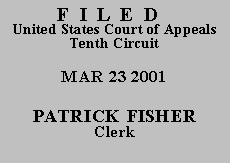

| UNITED STATES OF AMERICA, | No. 00-5221
(D.C. No. 00-CV-19-B) |
Before EBEL, KELLY and LUCERO, Circuit Judges.
Brown was convicted of bank robbery and possessing a firearm during a crime of violence, and was sentenced to a total of 562 months' imprisonment. (Doc. 65, at 1-2.) On direct appeal, we affirmed on the merits but remanded for the district court to correct its order regarding restitution. See United States v. Brown, No. 98-5206, 1999 WL 1127628 (10th Cir. Dec. 9, 1999).(1) Brown then filed a § 2255 motion, challenging his conviction on two new grounds: first, that his rights under the Speedy Trial Act, 18 U.S.C. §§ 3161-3162, were violated, and second, that his trial counsel was ineffective. (Doc. 91, at 5.)
The district court denied relief on both issues. (Doc. 105.) As cause for his failure to raise the Speedy Trial Act issue on direct appeal, Curley asserted ineffective assistance of appellate counsel. (Id. at 4.) The court found, however, that there was no violation of the Speedy Trial Act, so counsel was not ineffective for failing to raise the issue. (Id. at 7.) Brown was indicted on April 9, 1998, and jury selection took place on June 29, 1998. (Doc. 8 (indictment); vol. VII (jury selection). Thus, 81 days elapsed between the indictment and the trial. (Doc. 105, at 5.) Twelve of these days were excludable from the total because of pending defense motions. (Id. at 6.) The court therefore found that Brown had been brought to trial within the 70-day limit of the Speedy Trial Act.
Brown asserted his trial counsel was ineffective for failing to object when (1) his severed co-defendant was brought into the courtroom for purposes of identification; (2) the co-defendant's dye-stained socks were admitted as evidence; and (3) the case was transferred to a new judge for trial after the jury was sworn in. (Doc. 91 attach., at 11-12.) The district court found that because of the substantial evidence presented against Brown at trial, he was not prejudiced by any of his counsel's actions. (Doc. 105, at 8-9.)
Unless we issue a certificate of appealability, we lack jurisdiction over this appeal. See 28 U.S.C. § 2253(c). For substantially the reasons stated by the district court, we DENY a certificate of appealability and DISMISS this appeal.
ENTERED FOR THE COURT
David M. Ebel
Circuit Judge
*.After examining appellant's brief and the appellate record, this panel has determined unanimously that oral argument would not materially assist the determination of this appeal. See Fed. R. App. P. 34(a)(2) and 10th Cir. R. 34.1(G). The case is therefore ordered submitted without oral argument. This Order and Judgment is not binding precedent, except under the doctrines of law of the case, res judicata, and collateral estoppel. The court generally disfavors the citation of orders and judgments; nevertheless, an order and judgment may be cited under the terms and conditions of 10th Cir. R. 36.3.
1.We also denied a motion for mandamus on the Speedy Trial Act issue, noting that Brown could raise the issue in his § 2255 motion. See In re Brown, No. 00-5050 (10th Cir. Apr. 4, 2000) (DME panel) (Doc. 99.).